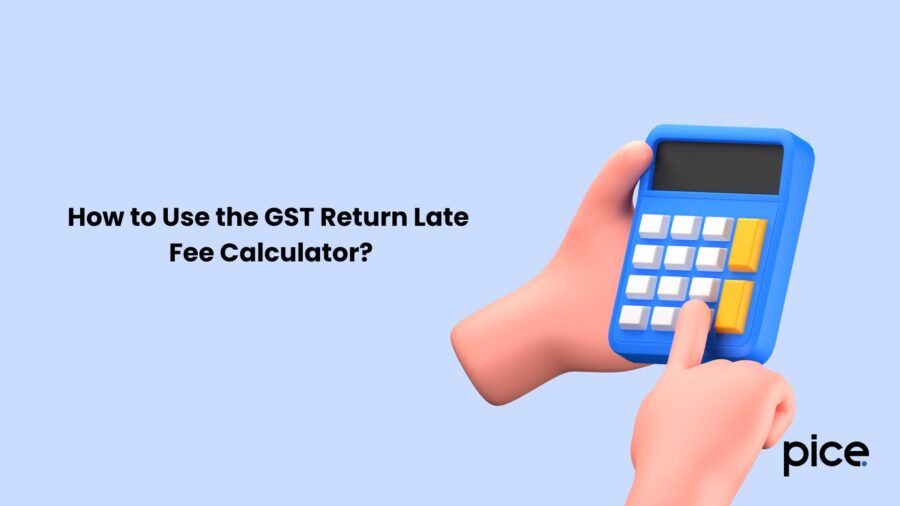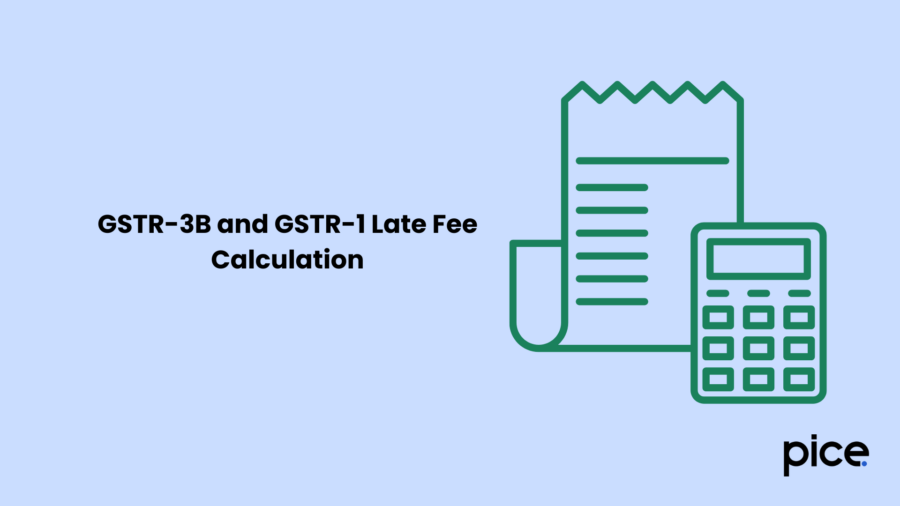How to Calculate Interest on Late Payment of GST?
- 8 Apr 25
- 8 mins

How to Calculate Interest on Late Payment of GST?
Key Takeaways
- Timely GST return filing helps businesses avoid penalties, interest, and late fees.
- A GST late fee and interest calculator simplifies the estimation of penalties for delayed returns.
- Interest on late GST payment is calculated at 18% per annum based on the delay period.
- GSTR-3B and GSTR-1 attract different late fees based on turnover, return type, and filing delay.
- Using online tools ensures accurate late fee calculation and reduces compliance burdens.
Goods and Services Tax (GST) compliance is essential for businesses operating in India. Any delay in filing GST returns can result in penalties, interest, and late fees. To ease the burden of calculating these additional charges, businesses can use an online GST late fee, interest, and penalty calculator.
These tools help taxpayers estimate the late fee and interest they owe based on the delay period, type of return, and tax liability.
Understanding GST penalties and late fees is crucial to avoid unnecessary costs and ensure timely compliance. In this guide, we will explore how to calculate interest on late payment of GST, how to use a GST return late fee calculator, the methods of computing interest and penalties, and specific details about GSTR-3B and GSTR-1 late fees.
How to Use the GST Return Late Fee Calculator?

A GST late fee calculator is a simple online tool that helps taxpayers compute their late fees and interest and also avoid GST late payment penalties. Here are the steps to use the GST return late fee calculator for a seamless filing of GST returns:
Step 1: Navigate to the drop-down menu and select the state.
Step 2: Choose the turnover category based on the previous year’s annual turnover.
Step 3: Fill in the period for which you have filed returns.
Step 4: Fill in the date when you want to file the return.
Step 5: Click on the check box for the return period corresponding to which you want to calculate the GST late fee for delayed filing.
Step 6: In case there is a nil tax liability for a specific month, click on the respective checkbox.
Step 7: Select 'Submit' to receive the PDF of the GST penalty calculation.
GST Interest and Late Fees Calculation on GST Returns
There can be penalties and interest levied for delayed or non-payment of GST returns, which can quite significantly hamper your financial planning. So, here are the calculation processes to understand:
Penalty for Filing Late Return
The GST return late filing fee applies from the due date till the actual date of return filing in case of delayed return filing. However, there is usually an upper limit to the maximum late fee charged. Moreover, the penalty amount might vary based on your aggregate annual turnover. For a lower return or lower turnover, the penalty levied might be small. The late return filing fee for GSTR-3B is ₹50 per day.
For instance, business X has an annual aggregate turnover of ₹10 lakh. If the due date for filing GSTR-3B returns for May 2023 is June 20th, 2023, and the business files the returns on July 10th, there will be a 20-day delay. The number of days of delay is an essential element in late fee calculation. Based on the annual turnover, the late fees will be ₹50 * 20 days = ₹1,000, subject to a maximum penalty limit of ₹5,000. The GSTR-3B late fee return calculator can help you estimate the late fee accurately.
Interest on Late Payment of GST
Besides late filing fee payment, if you fail to pay the outstanding GST amount within the due date, the government imposes an interest on the tax amount due. Notably, the interest rate varies based on the nature of the liability.
For instance, if the interest rate levied for delayed GST payment is 18% and the GST liability of the business is ₹50,000 for a specific tax period, here is the calculation:
GST payment date: July 10th
GST payment due date: June 20th
Number of days of delayed payment: 20 days
The interest amount payable by the business = ₹50,000 * 18% * 20 days/ 365 days = ₹492
Total GST liability: ₹50,000 + ₹492 = ₹50,492
GSTR-3B and GSTR-1 Late Fee Calculation

Here are the factors that determine the late filing fees payable to the Central and State Governments:
- Number of days of delayed filing: Actual filing date - Filing due date
- Turnover of the business: A higher annual aggregate turnover will likely result in a later due date
- Nature of return: The type of return further determines the late fee. For instance, the penalty for late return filing for nil returns is usually lower than regular return filing.
Late Fees for GSTR 3B
GSTR-3B is a monthly return form that entails details of inward supplies, outward supplies and the applicable tax liability of a taxpayer for a given tax period. Here is the list of due dates for filing GSTR-3B returns:
| Turnover Limit | Due Date for GSTR-3B Return Filing |
| Less than ₹5 crore | 20th of the month following the tax period |
| Exceeding ₹5 crore | 22nd of the month following the tax period (for Group 1 states)24th of the month following the tax period (for Group 2 states) |
The penalty payable per day for delayed GSTR-3B filing is ₹50 for normal returns and ₹20 for taxpayers with nil tax liability. This penalty amount includes CGST and SGST (Central Goods and Services Tax and State Goods and Services Tax) in equal amounts. Notably, the maximum late fees can be ₹10,000 with ₹5,000 CGST and SGST each.
Late Fees for GSTR 1
GSTR-1 is a monthly or quarterly return form providing details of outward supplies or goods and services. Here are the due dates for filing GSTR-1:
| GSTR-1 Return Filing Frequency | Due Date |
| Monthly Filing | 11th of the month following the tax period |
| Quarterly Filing | 13th of the month following the tax period or the concerned quarter |
The following table illustrates the late fees for filing Form GSTR-1
| Category of late Fee | Late Fee Per Day | Maximum Limit of Late Fee |
| Filing after the due date | ₹50 (₹25 CGST and SGST each) | ₹10,000 or the actual late fee whichever is lower |
| Late fee for taxpayers with nil tax liability | ₹20 (₹10 CGST and SGST each) | ₹500 or the actual late fee whichever is lower |
Here is the list of states in each group:
| Group 1 States | Group 2 States |
| ● Andaman and Nicobar Islands ● Chhattisgarh ● Andhra Pradesh ● Daman and Diu ● Dadra and Nagar Haveli ● Gujarat ● Goa ● Karnataka ● Lakshadweep ● Kerala ● Madhya Pradesh ● Puducherry ● Maharashtra ● Telangana ● Tamil Nadu | ● Arunachal Pradesh ● Bihar ● Assam ● Delhi ● Chandigarh ● Haryana ● Jammu and Kashmir ● Himachal Pradesh ● Jharkhand ● Ladakh ● Mizoram ● Meghalaya ● Nagaland ● Punjab ● Odisha ● Rajasthan ● Tripura ● Sikkim ● Uttarakhand ● West Bengal ● Uttar Pradesh |
Conclusion
Overall, now that you know how to calculate interest on late payment of GST, you need to know the applicable interest rate. You must also know the due date and the actual date of GST payment or return filing. However, manual calculations can be time-consuming and tedious, with the probability of inaccurate estimates.
You can use one online GST late payment interest calculator to simplify the process and ensure accuracy. Filing returns on time helps you avoid paying late fees, interest and penalties. Moreover, excess ITC claims or excess reduction can further affect the late fees.
FAQs
What is the penalty for late filing of GSTR-3B?
How is interest calculated on late GST payments?
Interest = Tax amount × 18% × Days of delay / 365.
Interest is mandatory even if late fees are waived.
What are the due dates for filing GSTR-1 and GSTR-3B?
GSTR-3B is due on the 20th for turnover below ₹5 crore, and the 22nd or 24th for higher turnover, depending on the state group. Filing after these dates incurs penalties.
Is there a different late fee for nil returns?
The maximum late fee for nil returns is ₹500 total (₹250 CGST + ₹250 SGST). Filing nil returns on time avoids unnecessary costs.
 By
By 















